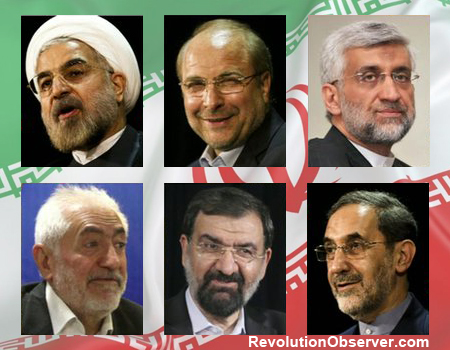By Adnan Khan
Several hundred hopefuls have submitted their names for approval to Iran’s Guardian Council – the powerful vetting and oversight committee of Iran – for the country’s June 14th presidential elections. The Guardian Council approved only eight candidates, although dozens of politicians and clerics withdrew their candidacies in support of more known figures. Current president, Mahmoud Ahmadinejad, is unable to run as presidential candidates are restricted to two terms in office. Whoever emerges victorious on June 14th will face significant challenges which include dealing with Iran’s reliance on oil and gas, a stagnant economy and the potential of losing Syria as an ally. Central to dealing with these challenges is the country’s political architecture, which, despite having weathered storms, faces challenges of its own.
It is important to understand that Iran’s political class is dominated by the clerics that participated in the Iranian revolution to oust the Shah in 1979. They created a political framework which has allowed them to dominate Iran and its politics ever since. At the apex of this system is the most powerful individual, the supreme leader, a position that has thus far been held by only two individuals. The first was the founder of the Islamic republic, Ayatollah Ruhollah Khomeini, who held the post from 1979 until his death in 1989. He was succeeded by his key aide and a former two-term president, Ayatollah Ali Khamenei, who has been supreme leader for the past two decades and is currently still in authority. The supreme leader is not elected by a public vote but rather by the Assembly of Experts, which is a group of high clerics. He has vast powers and appoints the leadership of the country’s most powerful political institutions, including the state broadcasting, the Joint Staff, the Islamic Revolutionary Guards Corps (IRGC) and the Guardians Council.
The potential unraveling of this political system has been evolving ever since Ahmadinejad came to power in 2005. Whilst rifts have always existed in Iran’s political system, Ahmadinejad was the first non-cleric to take such an important role. This intense infighting among clerical and political camps resulted in a situation where Iran’s leadership is facing a rapidly shrinking body of appropriate political candidates. Ahmadinejad has stood against the old clerical elite, accusing them of corruption, luxurious living and running the state for their own benefit rather than that of the people. Due to his popularity, he was able to undermine many clerics. With the clerics holding vast land, and many involved in big business, the struggling economy has seen much anger vented against the clerical establishment, which Ahmadinejad has been able to utilise for his own political ends.
Externally, Iran’s leadership faces the most serious challenge since 1979. Prior to the Arab Spring, Iran’s projection of power was getting stronger, from the Mediterranean, starting with Lebanon and Syria extending as far east as Afghanistan and back across the Persian Gulf to form a geographical area similar to a crescent, a term popularized by King Abdullah of Jordan to denote Iran’s regional influence. However the Arab Spring and the uprising in Syria has put this Shi’a crescent on life support. The IRGC, Iran’s elite forces, have been deployed in Syria, and Hezbollah, the group that Iran established and armed, has recently played a key role in maintaining Assad in Syria. While there are differences between the rival factions within Iran, it is in all of their interests to ensure Iran is the regional power and this has been a central tenant of the clerical regime since its inception.
Whatever the result of the presidential elections, Iran’s clerical regime and political leadership face significant social as well as internal problems, which have only exacerbated due to the regime’s failure to deal with them. 64% of Iran’s population is under the age of 34, born after the 1979 revolution and thus never witnessed it, while the political architecture is dominated by the 36% of the population born prior to 1979.[1] Iran’s energy infrastructure is crumbling since much of it was developed in the 1950’s, and poverty has increased dramatically. That has led many to turn to the West in the hope of ridding themselves of clerics, whom they see as an obstacle to material progress. Iranian society is polarized: with some youth admiring the West, and the wider religious base unable to comprehend how the Islamic texts deal with modern problems. Ahmadinejad came to power on a populist platform promising many reforms and a better economy, yet will leave office with the economy in an even worse state with very few reforms materializing beyond draft documents.
While the western media always portray Iran as a country ruled by Islamic clerics holding a freedom loving population hostage from values such as freedom and human rights, the reality is the regime in Iran is not Islamic and large segments of Iran demand Islam. Iran, in fact, has been no different than the other regimes in the region, with Islam and reform being promised but never delivered. Many supported the Iranian revolution in the hope that change would come to Iran through the ousting of the Shah, but soon after Khomeini came to power, his rule turned into a power grab. Similarly talks of reform, by Khatami, then by Rafsanjani, and most recently by Ahmadinejad, have never materialized, and this is leading to more internal tensions which is opening the door for foreign powers such as the EU to support certain Iranian groups, leading to yet more tensions.[2] The challenge for the clerical regime and whoever emerges victorious from the elections is to put the peoples’ interests before their own.
[1] http://unstats.un.org/unsd/demographic/sources/census/2010_PHC/Iran/Iran-2011-Census-Results.pdf
[2] http://www.irdiplomacy.ir/en/page/11841/Iran+asks+EU+not+to+support+%22terrorist%22+groups+spokesman.html


